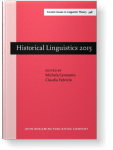Chapter 7
Where do Italian -ata nouns come from?
Some new diachronic evidence on a Romance derivational pattern
The issue of the rise of -ata action nouns has been intensively discussed. Two major hypothesis have been put forward to account for the emergence of this derivational pattern: according to the first one, -ata action nouns are participial nouns; according to the second one, -ata formations must be rather traced back to Latin -tus (<*-tū-) action nouns, through their neuter -tum variants. In this papers, new evidence is provided in support of the latter position. In particular, it is shown that the emergence of -ata nouns, both in Italian and in other Romance languages, is due to an overall reshaping of the nominalizing strategies in Late Latin, and is connected to the loss of ground of the -tus (<*-tū-) suffix, originally devoted to nominalize intransitive (mainly stative and achievement) predicates. Beyond their etymological source, -ata nouns are also investigated with regard to their functional role in the domain of Italian nominalizations, especially from the point of view of the interplay between the Aktionsart etc. of the predicate and the semantic value of the resulting action noun.
Article outline
- 1.Introduction
- 2.At the beginning of the story: the -tus (<*-tū-) suffix and its receding
- 3.Arguments supporting the -tus (<*-tū-) hypothesis
- 4.The so-called Romanian “supine”
- 5.The expansion of -ata nouns
- 6.The “place in the system” of -ata nouns
- 7.Conclusions
-
Aknowledgments
-
Abbreviations
-
Notes
-
References
